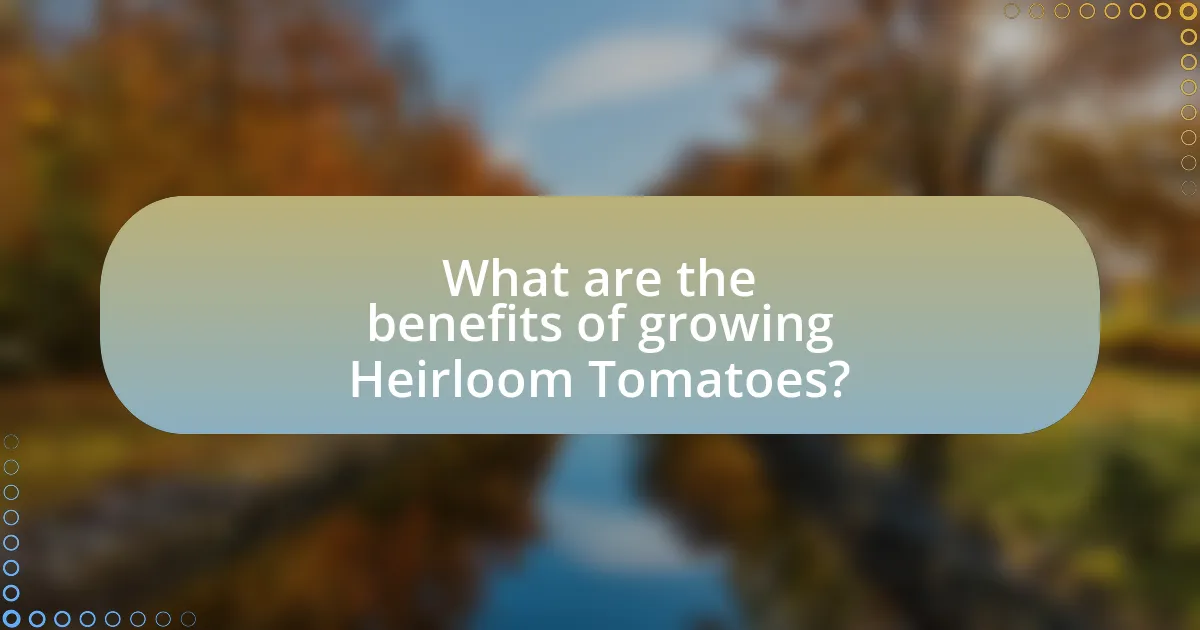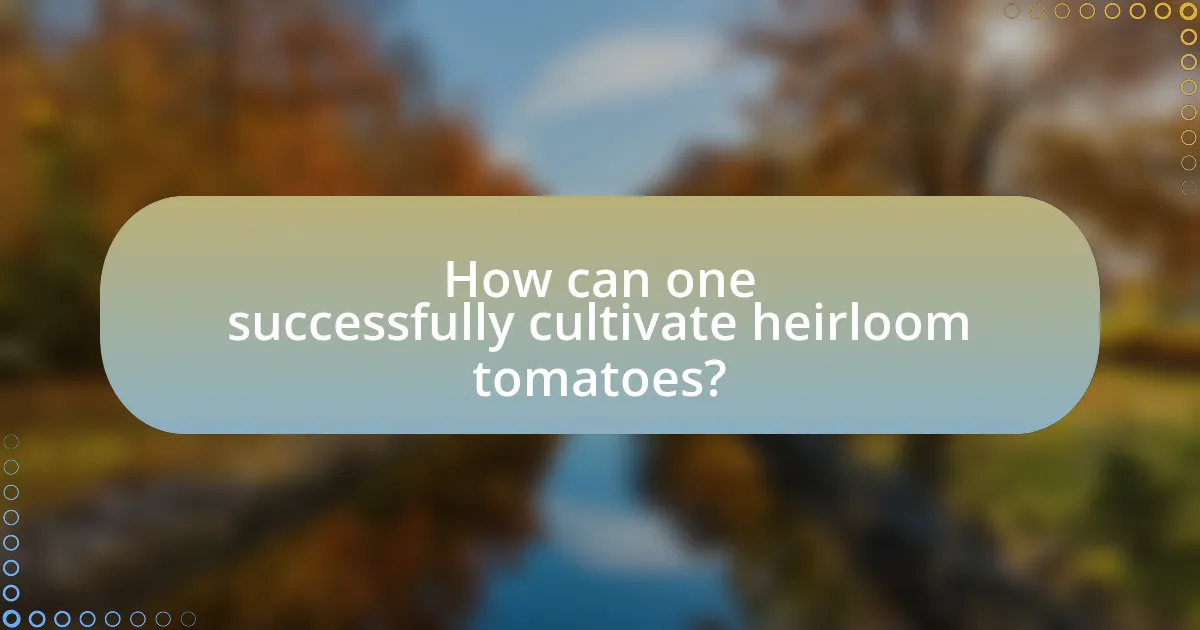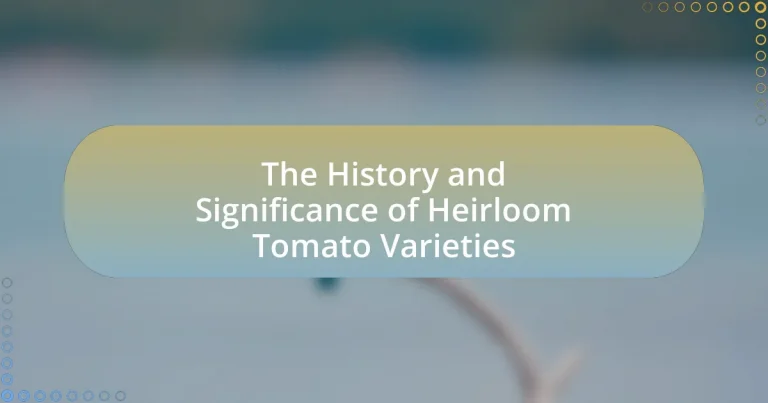Heirloom tomato varieties are traditional, open-pollinated cultivars that have been cultivated for at least 50 years, valued for their unique flavors, colors, and shapes. This article explores the definition, characteristics, and significance of heirloom tomatoes in agriculture, highlighting their role in preserving genetic diversity and cultural heritage. It discusses the historical context of heirloom tomatoes, their benefits in sustainable farming, and the challenges faced in their cultivation. Additionally, the article provides insights into effective growing practices, common pests and diseases, and resources available for enthusiasts, emphasizing the importance of heirloom tomatoes in promoting biodiversity and enhancing culinary experiences.

What are Heirloom Tomato Varieties?
Heirloom tomato varieties are traditional tomato cultivars that have been passed down through generations, often for at least 50 years. These varieties are valued for their unique flavors, colors, and shapes, which differ significantly from commercial hybrids. Heirloom tomatoes are typically open-pollinated, meaning they can be saved and replanted, preserving their genetic traits. The significance of heirloom tomatoes lies in their biodiversity and the preservation of agricultural heritage, as they contribute to the genetic diversity of crops and offer a taste of historical agricultural practices.
How are heirloom tomatoes defined?
Heirloom tomatoes are defined as open-pollinated varieties that have been cultivated and passed down through generations, typically for at least 50 years. These tomatoes are valued for their unique flavors, colors, and shapes, which often differ significantly from commercial hybrids. The term “heirloom” signifies a commitment to preserving genetic diversity and traditional farming practices, as these varieties are not mass-produced and are often grown by small-scale farmers or home gardeners.
What characteristics distinguish heirloom tomatoes from hybrids?
Heirloom tomatoes are distinguished from hybrids primarily by their open-pollinated nature, which allows them to be saved and replanted year after year without losing their unique characteristics. Heirloom varieties typically exhibit a wide range of colors, shapes, and flavors, often reflecting a rich genetic diversity that has been preserved over generations. In contrast, hybrid tomatoes are bred for specific traits such as uniformity, disease resistance, and higher yields, but they do not retain the same flavor complexity or genetic diversity when seeds are saved from the hybrid plants. Historical records indicate that heirloom tomatoes have been cultivated for over 100 years, often passed down through families, while hybrids are generally developed and marketed by seed companies for commercial production.
What are the different categories of heirloom tomatoes?
Heirloom tomatoes are categorized into three main types: open-pollinated, hybrid, and specific varieties based on color, shape, and size. Open-pollinated heirloom tomatoes are those that have been grown and selected for generations, maintaining their traits through natural pollination. Hybrid heirloom tomatoes, while not traditional, are created by crossbreeding two different varieties to produce specific characteristics. Additionally, heirloom tomatoes can be classified into various specific varieties, such as beefsteak, cherry, and plum, each distinguished by unique attributes like size, flavor, and culinary use. This classification reflects the diversity and historical significance of heirloom tomatoes in agriculture and cuisine.
Why are heirloom tomatoes significant in agriculture?
Heirloom tomatoes are significant in agriculture due to their genetic diversity and historical importance. These varieties, often passed down through generations, contribute to the preservation of unique traits that can enhance resilience against pests and diseases. For instance, heirloom tomatoes typically exhibit a wider range of flavors, colors, and shapes compared to commercial hybrids, which can lead to improved biodiversity in agricultural systems. Additionally, heirloom varieties are crucial for maintaining traditional farming practices and cultural heritage, as they often reflect the agricultural history of specific regions. This significance is underscored by the fact that many heirloom varieties are at risk of extinction, making their preservation vital for future agricultural sustainability.
How do heirloom tomatoes contribute to biodiversity?
Heirloom tomatoes contribute to biodiversity by preserving a wide range of genetic variations that are not found in commercial hybrid varieties. These tomatoes, often passed down through generations, encompass diverse colors, shapes, and flavors, which enhances the genetic pool of the species. According to the Seed Savers Exchange, heirloom varieties can include thousands of unique cultivars, each adapted to different climates and growing conditions, thereby promoting resilience in agricultural systems. This genetic diversity is crucial for food security and ecological stability, as it allows for adaptation to changing environmental conditions and pest pressures.
What role do heirloom tomatoes play in sustainable farming practices?
Heirloom tomatoes play a crucial role in sustainable farming practices by promoting biodiversity and preserving genetic diversity in agriculture. These varieties, often open-pollinated and non-hybrid, contribute to a more resilient ecosystem by providing a wider range of traits that can adapt to changing environmental conditions. For instance, heirloom tomatoes can be more resistant to pests and diseases, reducing the need for chemical pesticides. Additionally, their cultivation supports local economies and encourages organic farming methods, as many heirloom varieties thrive without synthetic fertilizers. This aligns with sustainable practices that prioritize environmental health and community well-being.
What historical context surrounds heirloom tomatoes?
Heirloom tomatoes have a historical context rooted in agricultural practices dating back to the pre-Columbian era, when indigenous peoples in the Americas cultivated various tomato species. These tomatoes were selectively bred for their unique flavors, colors, and shapes, leading to the diverse heirloom varieties we recognize today. By the late 19th century, heirloom tomatoes became popular among American gardeners, particularly in home gardens, as they were often passed down through generations, preserving genetic diversity. The term “heirloom” itself gained prominence in the 1980s, coinciding with a growing interest in organic farming and sustainable agriculture, highlighting the importance of preserving these traditional varieties against the backdrop of industrial agriculture’s rise.
How did heirloom tomatoes originate and evolve over time?
Heirloom tomatoes originated from traditional varieties cultivated by families and communities, often passed down through generations. These tomatoes evolved over time through selective breeding, which emphasized traits such as flavor, color, and adaptability to local growing conditions. Historical records indicate that heirloom varieties date back to the early 19th century in the Americas, where they were cultivated by indigenous peoples and later by European settlers. The preservation of these varieties became crucial as industrial agriculture favored hybrid tomatoes, which often lacked the rich flavors and diversity of heirlooms. Today, heirloom tomatoes are recognized for their unique characteristics and are celebrated in agricultural biodiversity efforts, highlighting their importance in sustainable farming practices.
What cultural significance do heirloom tomatoes hold in various regions?
Heirloom tomatoes hold significant cultural value in various regions due to their historical ties to local agriculture and culinary traditions. In the United States, for example, heirloom varieties are celebrated for their unique flavors and colors, often linked to family heritage and regional identity, with many varieties passed down through generations. In Italy, heirloom tomatoes are integral to traditional dishes, reflecting the country’s agricultural diversity and regional specialties, such as the San Marzano tomato, which is protected by the PGI status, emphasizing its cultural importance. Additionally, in Mexico, heirloom tomatoes are part of indigenous farming practices, showcasing biodiversity and traditional knowledge that contribute to local cuisines. These examples illustrate how heirloom tomatoes serve not only as food sources but also as symbols of cultural heritage and community identity across different regions.

What are the benefits of growing Heirloom Tomatoes?
Growing heirloom tomatoes offers several benefits, including superior flavor, genetic diversity, and sustainability. Heirloom tomatoes are known for their rich, complex flavors that often surpass those of hybrid varieties, making them a favorite among chefs and home cooks. Additionally, these tomatoes come from open-pollinated seeds, which means they can be saved and replanted year after year, promoting biodiversity and reducing reliance on commercial seed sources. This practice supports sustainable agriculture by preserving unique varieties that may be better adapted to local growing conditions. Furthermore, heirloom tomatoes often have a higher nutritional value, containing more vitamins and antioxidants compared to conventional varieties.
How do heirloom tomatoes compare in flavor and nutrition to other varieties?
Heirloom tomatoes generally offer a richer flavor and higher nutritional value compared to many commercial varieties. The flavor profile of heirloom tomatoes is often described as complex and sweet, attributed to their diverse genetic backgrounds and traditional growing methods. In terms of nutrition, heirloom tomatoes tend to have higher levels of antioxidants, vitamins A and C, and other phytonutrients, which are beneficial for health. Studies have shown that heirloom varieties can contain up to 50% more vitamin C than standard hybrid tomatoes, reinforcing their nutritional superiority.
What unique flavors can be found in different heirloom tomato varieties?
Heirloom tomato varieties exhibit a wide range of unique flavors, including sweet, tangy, and savory profiles. For instance, the Brandywine heirloom tomato is renowned for its rich, sweet flavor, while the Green Zebra offers a tangy, slightly tart taste. The Cherokee Purple variety is celebrated for its complex, smoky flavor with hints of sweetness. These flavor distinctions arise from the diverse genetic backgrounds and growing conditions of heirloom tomatoes, which have been cultivated for generations. Research indicates that heirloom varieties often possess higher levels of sugars and acids, contributing to their distinctive taste profiles compared to commercial hybrids.
How do heirloom tomatoes contribute to a healthy diet?
Heirloom tomatoes contribute to a healthy diet by providing essential nutrients, antioxidants, and dietary fiber. These tomatoes are rich in vitamins A and C, which support immune function and skin health. Additionally, heirloom varieties often contain higher levels of antioxidants, such as lycopene, which has been linked to reduced risk of chronic diseases, including heart disease and certain cancers. The fiber content in heirloom tomatoes aids in digestion and promotes a feeling of fullness, which can help with weight management. Studies have shown that diets rich in fruits and vegetables, including heirloom tomatoes, are associated with lower rates of obesity and related health issues.
What are the challenges of growing heirloom tomatoes?
Growing heirloom tomatoes presents several challenges, including susceptibility to diseases, inconsistent yields, and specific growing conditions. Heirloom varieties often lack the disease resistance found in hybrid tomatoes, making them more vulnerable to issues like blight and pests. Additionally, heirloom tomatoes can produce variable yields due to their genetic diversity, which can lead to fluctuations in fruit size and quantity. They also typically require specific soil conditions and care, such as consistent watering and nutrient management, to thrive effectively. These factors contribute to the complexity of successfully cultivating heirloom tomatoes compared to more commercially viable varieties.
What common pests and diseases affect heirloom tomatoes?
Common pests that affect heirloom tomatoes include aphids, spider mites, and whiteflies, while diseases such as blight, blossom end rot, and bacterial wilt are prevalent. Aphids can transmit viruses and weaken plants, spider mites cause leaf damage, and whiteflies can lead to stunted growth. Blight, particularly late blight, can devastate crops, while blossom end rot results from calcium deficiency, and bacterial wilt can kill plants rapidly. These pests and diseases pose significant challenges to heirloom tomato cultivation, necessitating effective management strategies.
How can growers effectively manage these challenges?
Growers can effectively manage challenges related to heirloom tomato varieties by implementing integrated pest management (IPM) strategies, selecting disease-resistant cultivars, and practicing crop rotation. IPM combines biological, cultural, and chemical practices to minimize pest damage while reducing reliance on pesticides. For instance, using beneficial insects can control pests naturally, while selecting disease-resistant heirloom varieties can significantly lower the incidence of common tomato diseases. Crop rotation disrupts pest and disease cycles, enhancing soil health and reducing the buildup of pathogens. Research indicates that these methods can lead to improved yields and healthier plants, demonstrating their effectiveness in managing the challenges associated with heirloom tomato cultivation.
What cultivation practices are best for heirloom tomatoes?
The best cultivation practices for heirloom tomatoes include selecting disease-resistant varieties, providing adequate sunlight, maintaining consistent soil moisture, and using organic fertilizers. Heirloom tomatoes thrive in well-drained, nutrient-rich soil with a pH between 6.0 and 6.8, which supports healthy growth and fruit development. Additionally, regular pruning of suckers helps improve air circulation and sunlight exposure, leading to better yields. Research indicates that heirloom varieties often require more attention to pest management, as they may be more susceptible to certain diseases compared to hybrid varieties. Implementing crop rotation and companion planting can further enhance their resilience and productivity.
How should heirloom tomatoes be planted and cared for?
Heirloom tomatoes should be planted in well-drained, nutrient-rich soil with a pH between 6.0 and 6.8, ideally after the last frost date when soil temperatures reach at least 60°F. To care for heirloom tomatoes, provide consistent watering, aiming for 1-2 inches per week, and apply organic mulch to retain moisture and suppress weeds. Additionally, support the plants with stakes or cages to promote healthy growth and prevent disease. Regularly monitor for pests and diseases, and use organic methods for control when necessary. These practices ensure optimal growth and yield, as supported by agricultural studies highlighting the importance of soil quality and moisture management in tomato cultivation.
What are the best soil and environmental conditions for heirloom tomatoes?
Heirloom tomatoes thrive best in well-draining, loamy soil with a pH level between 6.0 and 6.8. This type of soil provides the necessary nutrients and moisture retention for optimal growth. Additionally, heirloom tomatoes require full sun exposure, ideally receiving at least 6 to 8 hours of direct sunlight daily, which promotes healthy fruit development. The ideal temperature range for growing heirloom tomatoes is between 70°F and 85°F during the day and not dropping below 55°F at night, as these conditions support vigorous growth and fruit set.

How can one successfully cultivate heirloom tomatoes?
To successfully cultivate heirloom tomatoes, one must select disease-resistant varieties, provide well-draining soil enriched with organic matter, and ensure consistent watering while avoiding overhead irrigation. Heirloom tomatoes thrive in full sun, requiring at least six to eight hours of direct sunlight daily, which promotes healthy growth and fruit development. Additionally, maintaining proper spacing between plants allows for adequate air circulation, reducing the risk of fungal diseases. Research indicates that heirloom varieties often have unique flavor profiles and are more resilient to local growing conditions, making them a valuable choice for gardeners.
What tips can help ensure a successful heirloom tomato harvest?
To ensure a successful heirloom tomato harvest, select disease-resistant varieties suited to your climate. Heirloom tomatoes thrive in well-drained, nutrient-rich soil with a pH between 6.0 and 6.8, which promotes optimal growth. Regular watering, ideally at the base of the plant to avoid leaf wetness, helps prevent diseases. Additionally, providing adequate sunlight—at least six to eight hours daily—enhances fruit development. Implementing crop rotation and companion planting can further reduce pest issues and improve soil health. Research indicates that heirloom varieties often yield better flavor and nutritional value, making these practices essential for maximizing harvest quality.
How can proper watering techniques improve heirloom tomato growth?
Proper watering techniques significantly enhance heirloom tomato growth by ensuring consistent moisture levels that promote healthy root development and fruit production. Heirloom tomatoes require deep watering to encourage roots to grow downwards, which increases their resilience to drought and improves nutrient uptake. Research indicates that tomatoes benefit from approximately 1-2 inches of water per week, depending on environmental conditions, which helps prevent issues like blossom end rot and cracking. Additionally, using techniques such as drip irrigation minimizes water waste and reduces the risk of fungal diseases by keeping foliage dry.
What fertilization methods are most effective for heirloom tomatoes?
The most effective fertilization methods for heirloom tomatoes include the use of organic fertilizers, compost, and balanced nutrient solutions. Organic fertilizers, such as well-rotted manure or fish emulsion, provide essential nutrients while improving soil structure and microbial activity. Compost enriches the soil with organic matter, enhancing moisture retention and nutrient availability. Balanced nutrient solutions, particularly those with a ratio of nitrogen, phosphorus, and potassium (N-P-K) around 5-10-10, support healthy growth and fruit development. Research indicates that heirloom tomatoes benefit from these methods due to their sensitivity to nutrient imbalances, which can affect yield and flavor.
What are common mistakes to avoid when growing heirloom tomatoes?
Common mistakes to avoid when growing heirloom tomatoes include improper watering, neglecting soil health, and failing to provide adequate support. Overwatering or underwatering can lead to root rot or stress, respectively, which negatively impacts growth. Soil health is crucial; heirloom tomatoes thrive in nutrient-rich, well-draining soil, so neglecting to amend the soil can hinder their development. Additionally, heirloom varieties often require staking or caging for support, and failing to provide this can result in broken stems and reduced yields.
How can overwatering or underwatering affect heirloom tomato plants?
Overwatering or underwatering can severely impact heirloom tomato plants by causing root rot or stress, respectively. Heirloom tomatoes require consistent moisture; excessive water saturates the soil, leading to oxygen deprivation and fungal diseases, while insufficient water results in wilting, blossom end rot, and reduced fruit quality. Studies indicate that heirloom varieties are particularly sensitive to water fluctuations, making proper irrigation essential for optimal growth and yield.
What are the signs of nutrient deficiencies in heirloom tomatoes?
Signs of nutrient deficiencies in heirloom tomatoes include yellowing leaves, stunted growth, and poor fruit development. Specifically, nitrogen deficiency manifests as older leaves turning yellow, while phosphorus deficiency results in dark green leaves with purple undertones. Potassium deficiency can cause leaf edges to scorch and fruit to develop poorly. These symptoms are well-documented in agricultural studies, indicating that proper nutrient management is crucial for optimal heirloom tomato health and yield.
What resources are available for heirloom tomato enthusiasts?
Heirloom tomato enthusiasts can access a variety of resources, including seed catalogs, gardening books, online forums, and local gardening clubs. Seed catalogs, such as those from Seed Savers Exchange and Baker Creek Heirloom Seeds, provide extensive selections of heirloom varieties along with growing tips. Gardening books like “Heirloom Tomatoes: How to Grow and Taste the Best Tomatoes Ever” by Craig LeHoullier offer in-depth knowledge on cultivation and history. Online forums, such as those on Reddit or specialized gardening websites, facilitate community discussions and knowledge sharing. Local gardening clubs often host events and workshops focused on heirloom tomatoes, providing hands-on experience and networking opportunities for enthusiasts.
Where can one find heirloom tomato seeds and plants?
Heirloom tomato seeds and plants can be found at specialty seed companies, local nurseries, farmers’ markets, and online retailers. Companies such as Baker Creek Heirloom Seeds and Seed Savers Exchange offer a wide variety of heirloom tomato seeds, while local nurseries often carry heirloom plants during the growing season. Farmers’ markets frequently feature vendors who sell heirloom varieties, providing an opportunity to purchase both seeds and plants directly from growers. Online platforms like Amazon and Etsy also list heirloom tomato seeds from various sellers, ensuring a broad selection for gardeners.
What online communities or organizations support heirloom tomato growers?
Online communities and organizations that support heirloom tomato growers include the Seed Savers Exchange, which focuses on preserving heirloom seeds and promoting biodiversity, and the Heirloom Tomato Society, dedicated to educating growers about heirloom varieties. Additionally, forums like GardenWeb and social media groups on platforms such as Facebook provide spaces for growers to share experiences and resources. These organizations and communities facilitate knowledge exchange, seed sharing, and support for sustainable growing practices, reinforcing the importance of heirloom tomatoes in agricultural diversity.





